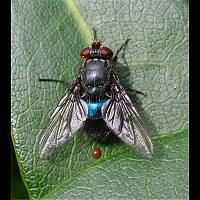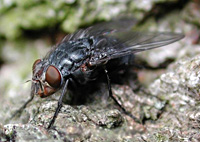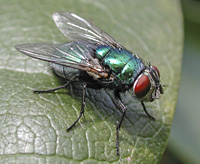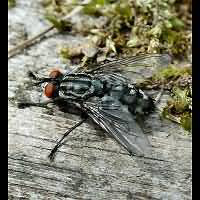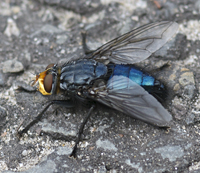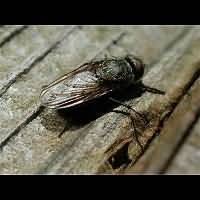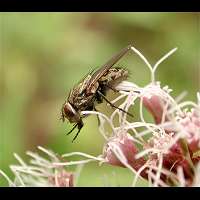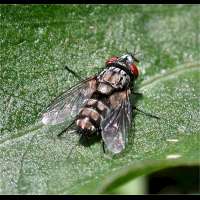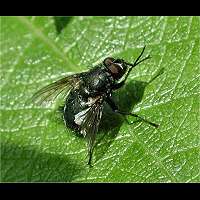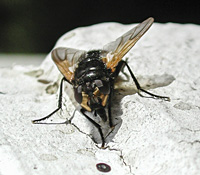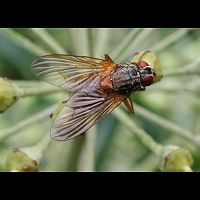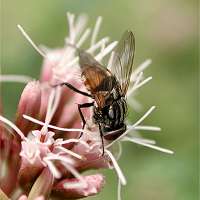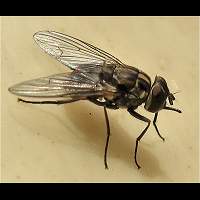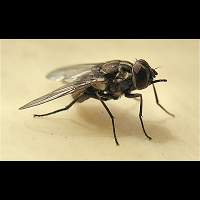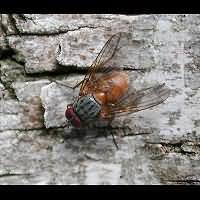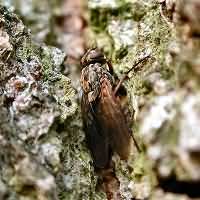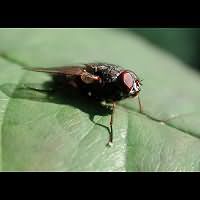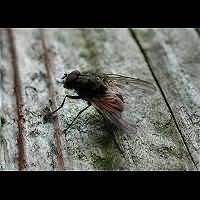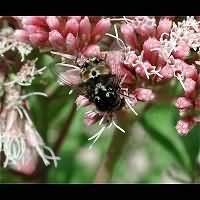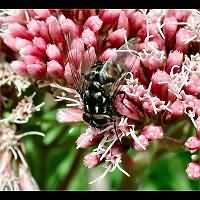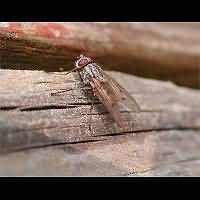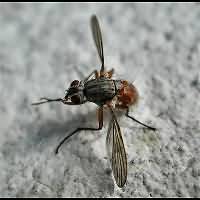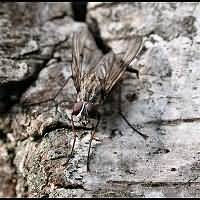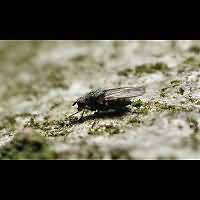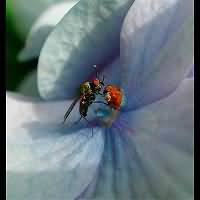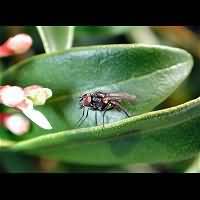[All pictures of garden wildlife on this page are thumbnails. Click on any thumbnail for a large format to be displayed.]
Flesh Flies, Blow Flies and House Flies
Content: 1 Flesh and Blow Flies, 2 House Flies and Root-maggot Flies.
![]()
1 Flesh Flies and Blow Flies (Sarcophagidae and Calliphoridae)
In these families of flies one finds some very common species. The Bluebottle deposits its eggs in rotting meat. The eggs often hatch instantly. Even though there are a few similar species, they are so hard to distinguish that we use the name Blue Bottle without worrying about the exact species concerned. Actually in most insect guides Calliphora vomitoria is shown as the best example of a bluebottle. But chances are you'll never see it, for it has become very rare. The most common bluebottle, especially in gardens is Calliphora vicina, which has the face rather reddish brown just below the eyes.
Common in gardens and sometimes buzzing indoors is this Bluebottle: Calliphora vicina.
The Green Bottle lives in the same way the Blue Bottle does. Still we are not sure that this is the Green Bottle. There are many species of green flies and they all look exactly the same. As the one below is not very hairy, it qualifies being a Flesh Fly and not the parasitic Green Fly. The real Green Bottle gets a golden or copper glow later on. Some close relatives of the greenbottle are horrible: they lay their eggs in living beings. The eggs hatch and the larvae eat the beings. In Europe toads and sheep sometimes suffer fr these flies, looking exactly like Green Bottles, by the way. In some tropical parts of the world however humans are affected as well, sometimes killing the infected person. The Common Flesh Fly, below on the right, also deposits its eggs in rotting meat. For a long time it was assumed that its larvae also ate the meat, but now we know the larvae are predators that eat other larvae. Its Latin name Sarcophaga carnaria would make a good title for a horror movie. By the way: it is not certain the species in the picture below really is Sarcophaga carnaria. In the genus Sarcophaga we find some 30 native species, which are extremely hard to identify.
To the left: the well known Greenbottle (Lucilia sp.). In the middle: the equally well known Gray Flesh Fly (Sarcophaga carnaria or relative). To the right: 'the fly of the dead' Cynomya mortuorum
Flies belonging to the genus Pollenia look much like ordinary flies. They are black, but softly glisten in the sunshine. That is because they have short, goldenbrown hairs on the thorax. The adults can be found on excrements, including those of humans. The larvae live a parasitic life in earth worms. In autumn the adults fly into our houses. They look for a place in attics to hibernate. Once hibernating the flies sit very still and it is almost impossible to wake them. They do no harm to you or your house. The species below to the left certainly belongs to the Pollenia genus, but we can't be sure that it is Pollenia rudis, even though this is the commonest species in Central Europe. This species often appears in large numbers. So does the Autumn (or Face) Fly and various Blow Flies. Collectively these species are known as Cluster Flies or Clustering Flies. We thank Tony Irwin for his help naming this species. Below to the right a Pollenia fly we haven't been able to name yet.
To the left: the female of one of the Cluster Flies (most probably Pollenia rudis). To the right: another, but still nameless Pollenia species.
In the genus Metopia there are several similar species. You can't identify them from just a picture. The males are almost entirely black and similar to many other black flies. The females have a large, silvry, protruding 'nose'. Their bodies are black with silvry greyish, very variable markings. These are interesting flies, for they are so-called cleptoparasites to big parasitic wasps. After making a nest the female wasp will go hunting for a prey. She leaves her nest open and the female fly will go in and deposit her egg. After hatching the fly larva will eat the food provided by the parasitic wasp. Life can be so easy, can't it?
The genus Metopia is comprised of cleptoparasitic flies. To the left a female and to the right a male.
2 House Flies and Root-maggot Flies (Muscidae and Anthomyiidae)
Man's best friend is the House Fly. Originally this was a tropical species. Men took it to the colder parts of the world as well. It manages to survive the winters in Europe and Northern America. It is not easy for the House Fly and most of them don't survive winter. Luckily the animal is capable producing no less than thirteen generations in just one season! In this way there are so many House Flies, that a sufficient number lives through winter. The Root-maggot Flies (Anthomyiidae) do look like the houseflies very much and are sometimes considered to be a subfamily of the houseflies only. From pictures it is often even impossible to tell the two groups apart and that is why we have decided to deal with both groups at once. Below you see two close relatives of the House Fly. To the left the Mid-day Fly. It deposits its eggs in dung and can be seen taking sunbaths in fall. It never enters houses. Even though most members of this Fly family live on and in rubbish, decaying materials or dung heaps, some hunt for other larvae, like the larvae of the Mid-day Fly.
Two members of the House Flies family: to the left the Mid-day Fly (Mesembrina meridiana) and to the right Mydaea scutellaris.
The Autumn Housefly below can be a real nuisance. In autumn it may invade our homes in great numbers, looking for a place to hibernate. In summer it pesters horses and especially cows by sitting on and near the eyes. That is why it is also known as the Face Fly. It may transfer a desease as well as a parasite. In spite of both the common name and the scientific name it not only appears in autumn, but from summer onwards. The larvae live in dung. Adults feed on animal juices (tears, blood) and nectar from flowers. Most of the flies found on cattle are females, for they need more proteins to produce the eggs.
This Autumn House Fly is also known as the Face Fly, because it sits near the eyes of cattle in great numbers.
The Face Fly may be a pest for cattle, the Stable Fly is a pest for vcattle and humans alike. It is similar to the Common House Fly. But studying it closely revealts a firm, short, stinging snout. With it it sucks blood from mammals, including cattle and humans. Cattle usually is stung in the lower half of the body. Attacks on humans concentrate on the lower legs, especially the ankles. The sting is painful, nut less so than the sting of a wasp. But as the Stable Fly may appear in great numbers, this is not much of a consolation. The larvae are found in dung.
This fly delivers painful stings: the Stable Fly (Stomoxys calcitrans).
The larvae of the Phaonia flies live in decaying wood. The flies are very common in woodlands, and are usually found on trees. They feed on dung however. Most of these flies have a grey thorax and a reddish or brownish abdomen. We thank various people for their help on these ones, especially Tony Irwin from Norwich.
To the left Phaonia rufiventris and to the right another Phaonia sp., most probably Phaonia errans.
It is very difficult to tell the members of this family apart, so if you can help us identifying one or more species, please mail to: info@gardensafari.net. House Flies often live inside our house, but you should always treat them as unwelcome visitors, for they carry many diseases, running from food poisoning bacteria to thyphoid and cholera.
Two House Flies that we were unable to identify.
Below a very beautiful member of the House Fly family. It is a rather colourful fly and has been identified by Date Lutterop. Hij used not only the colours and looks of the fly, but paid attention to the veins in the wings as well. This is a male and as with many other fly species males can be seperated from females by looking at the eyes. Males have big eyes hardly separated from oneanother, while females have much smaller eyes, clearly sranding apart. In this case though, the distinction also lies in the colouring: the females are plain grey with lighter markings. The males of this species are more colourful than the females: on the abdomen they have orange spots, which the females don't have. The larvae live in moist dead leaves and are hunters.
This very beautiful fly is called Graphomyia maculata.
The Root-maggot Flies often have a smaller body than the House Flies. But in most other respects they really do look alike. It is very difficult to put a name on them. From pictures one can not even tell to which group an individual fly belongs. This goes for the flies below. The one to the right was trapped in a cob web and therefor easy to photograph. Luckily though, it got loose in the end and flew away.
We do not know whether these are Root-maggot Flies or a House Flies.
Below are two more species that could be House Flies, or Root-maggot Flies. And if you do look at all these pictures you do notice only very small differences between all these animals. If you just glance however, they all look alike. And it is particularly hard to imagine we are talking about two entire families of flies! We like to thank Tony Irwin for his help identifying these flies.
Two more flies belonging to this hard to identify group.
Below you see two more root-maggot flies. World-wide there are over 1,100 species, mainly in Europe, Northern Asia and Northern America, with fewer species in the Tropics. Root-maggot flies sometimes become a pest in agriculture, for the larvae may weaken certain plants. Especially when they appear in large numbers, the damage can be substantial. The most notorious species is the Seed Corn Maggot, which lives in both maize and beans. The larvae of a few smaller species live inside leaves and mine these. The larvae of most species are harmless though: they live in decaying material, such as litter and fallen leaves. Most species live in woodlands or moist areas. We like to thank Tony Irwin for his help identifying these two.
Two root-maggot flies. Their body is often much smaller than that of a typical house fly.


© Copyright 1998-2024 gardensafari.net (Hania Berdys)

 English / engels
English / engels  Dutch / nederlands
Dutch / nederlands